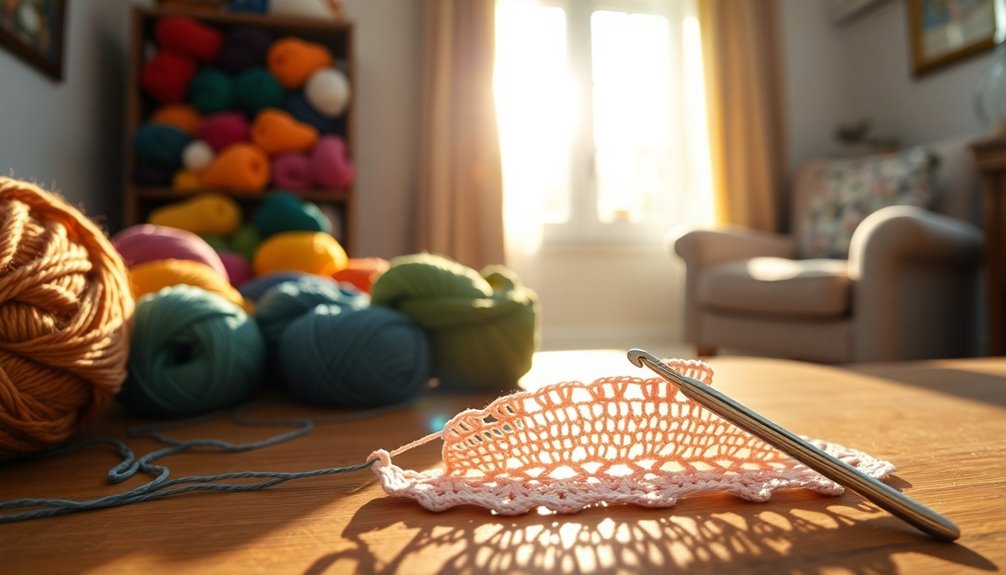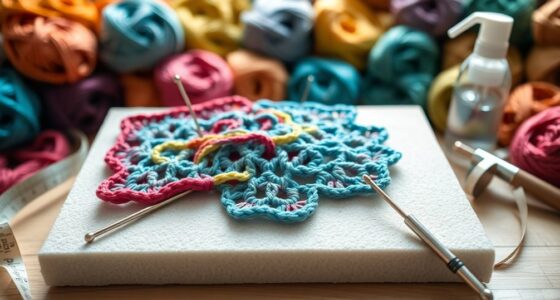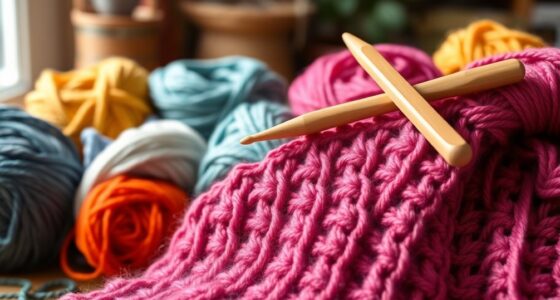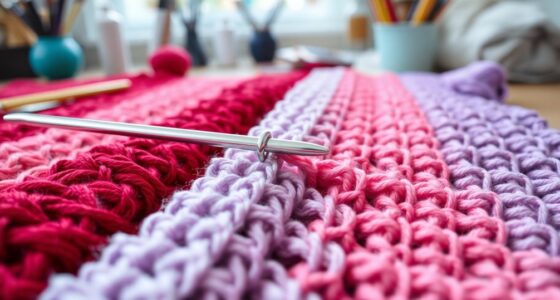Crochet isn't as hard as it seems! With a bit of practice and the right techniques, you'll be creating beautiful projects in no time. Start with a proper grip and essential stitches like single and double crochet. Simple projects, like granny squares or scarves, can boost your confidence. Remember, mistakes are part of the journey, and learning from them makes you a better crocheter. Keep going, and you'll discover even more tips to enhance your skills!
Key Takeaways
- Crochet can be daunting initially, but mastering basics like stitches and grip significantly enhances comfort and confidence.
- Simple projects, such as granny squares or coasters, allow beginners to practice and build skills gradually.
- Utilizing online resources, especially YouTube tutorials, provides visual guidance and reinforces learning through repetition.
- Mistakes are part of the learning process; reflecting on them promotes resilience and improves technique.
- With patience and practice, crochet becomes easier, allowing for progression to more complex projects over time.
Understanding the Basics of Crochet
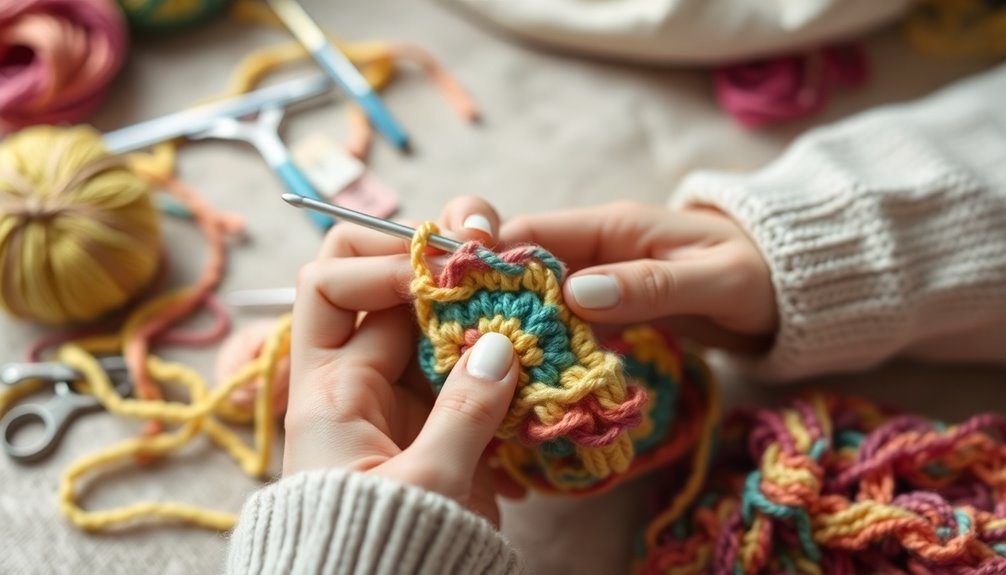
When you first plunge into crochet, it might seem intimidating, but understanding the basics can make all the difference.
Start by learning to hold the hook and yarn correctly; this simple adjustment sets the stage for success. The chain stitch is your first step, allowing you to get comfortable with yarn manipulation.
Don't hesitate to explore online resources like YouTube tutorials—they offer invaluable step-by-step guidance for learning to crochet. Familiarizing yourself with crochet terminology will help you navigate patterns more effectively.
Remember, persistence is key; even if you struggle with tension or technique at first, practice leads to improved crochet skills and greater confidence.
Embrace the journey, and you'll soon find crochet enjoyable and rewarding.
Essential Equipment for Beginners
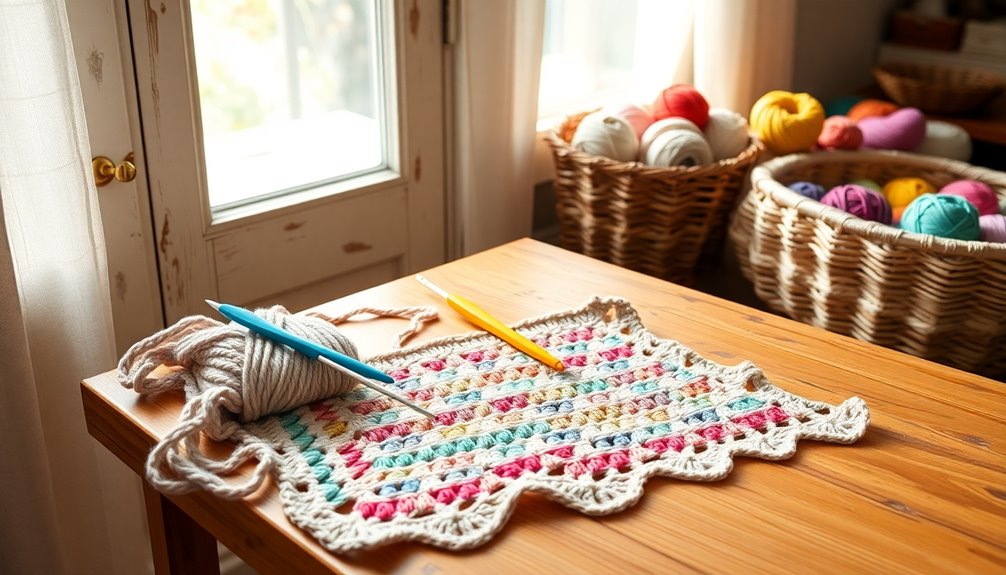
To get started with crochet, you don't need much—just a few essential tools that can make the learning process smoother.
For beginners, having the right crochet hook and yarn is vital. A recommended size is the H-8 (5 mm) crochet hook, which is comfortable to use.
When choosing yarn, opt for medium-weight cotton or light-colored yarn; this helps you see your stitches clearly and manage tension effectively.
- Crochet Hook: H-8 (5 mm) is ideal for beginners.
- Yarn: Use medium-weight (DK, #4) and light colors.
- Batch Consistency: Purchase yarn from the same batch for larger crochet projects to avoid color discrepancies.
Additionally, starting with healthy ingredients in your projects can inspire creativity and enhance your crochet journey.
With these essentials, you're well on your way to enjoying crochet!
Different Grips and Techniques
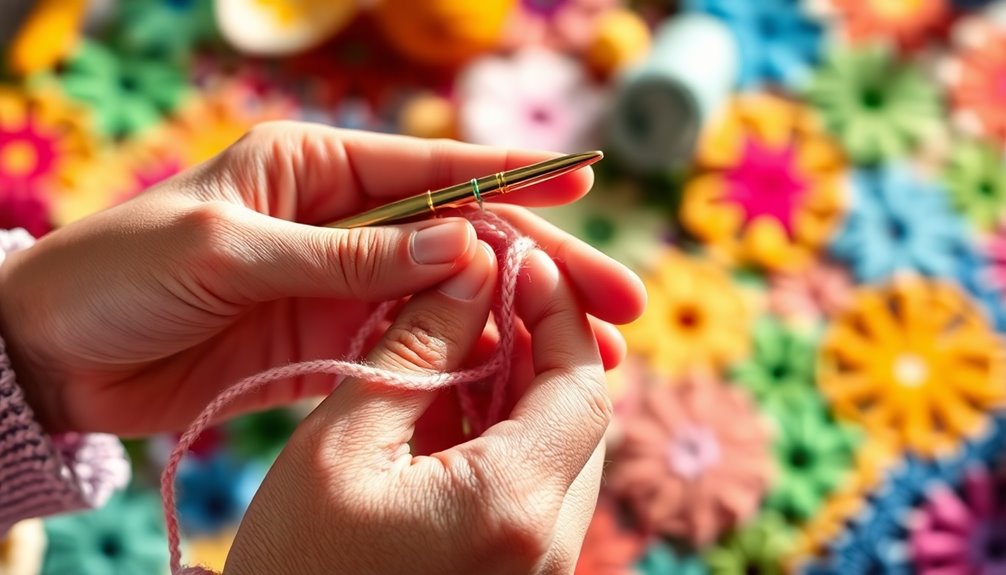
When you start crocheting, your grip on the hook can make all the difference in your comfort and technique.
You might find that the pen grip or knife grip works best for you, so experimenting with both can enhance your experience.
As you practice fundamental stitches, focusing on your grip will help you gain confidence and improve your skills.
Grip Styles Explained
Two main grip styles dominate the world of crochet: the pen grip and the knife grip. Each method has its advantages, and finding what works best for you can enhance your crocheting experience.
With the pen grip, you hold the hook like a pen, allowing for smoother movements. In contrast, the knife grip resembles holding a knife, providing better control for certain crochet stitches.
- Experiment with both grips to discover your preference.
- A consistent grip on the hook is essential for creating even tension.
- Over time, your chosen grip will lead to greater speed and fluidity.
Ultimately, there's no right or wrong way; it's all about what feels comfortable for you! Additionally, maintaining consistent tension is crucial for achieving the best results in your crochet projects.
Techniques for Beginners
Finding the right grip style can make a difference as you start exploring various crochet techniques. Whether you prefer the pen grip or the knife grip, choose what feels comfortable for you—there's no right or wrong way!
As you immerse yourself in this new skill, begin with simple projects like granny squares or crochet chains. These basics help you practice essential techniques like yarning over and maintaining consistent tension.
Focus on mastering basic crochet stitches such as single crochet, half double crochet, double crochet, and treble crochet. Experienced crocheters recommend making sample swatches before tackling intricate designs to verify you're comfortable with the stitches and gauge. Additionally, exploring different grips can enhance your comfort and efficiency while crocheting.
Regular practice will develop your muscle memory and improve your overall technique over time.
Starting With Simple Projects
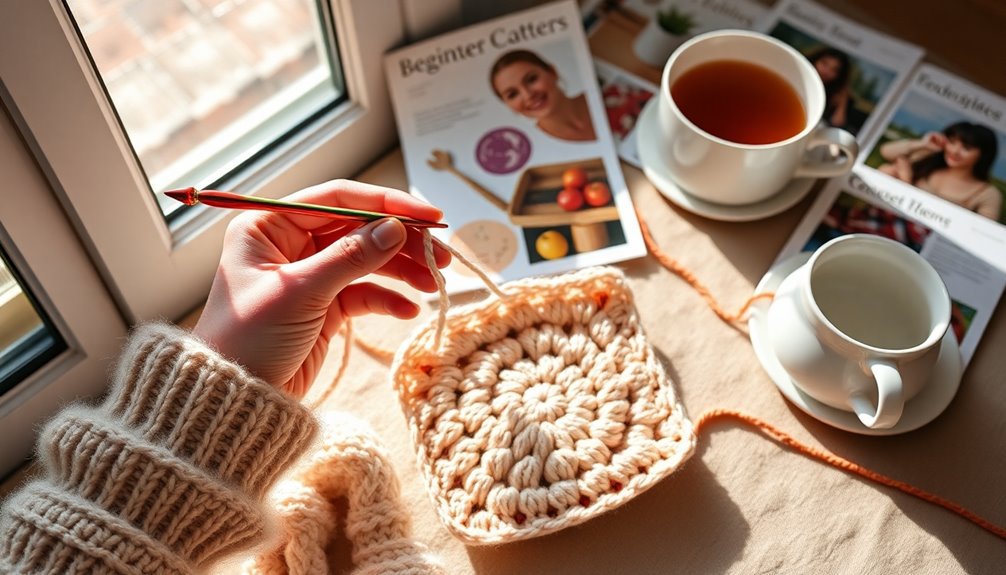
Starting with simple projects is a great way to ease into crochet and boost your confidence. When you tackle easy items, you'll get to practice essential techniques and enjoy tangible results.
Begin by focusing on a few key stitches, like the single crochet, which can be used in various different projects. Here are some ideas to kickstart your crochet journey:
- Create granny squares to master stitch consistency.
- Make simple coasters for quick wins.
- Try a basic scarf to practice your tension.
As you crochet in the US, remember that online tutorials can enhance your learning. Additionally, starting small helps you build skills gradually, making the world of crochet much less intimidating and more enjoyable, similar to how layering textures and colors can create a cozy atmosphere in interior design.
Mastering Basic Crochet Stitches
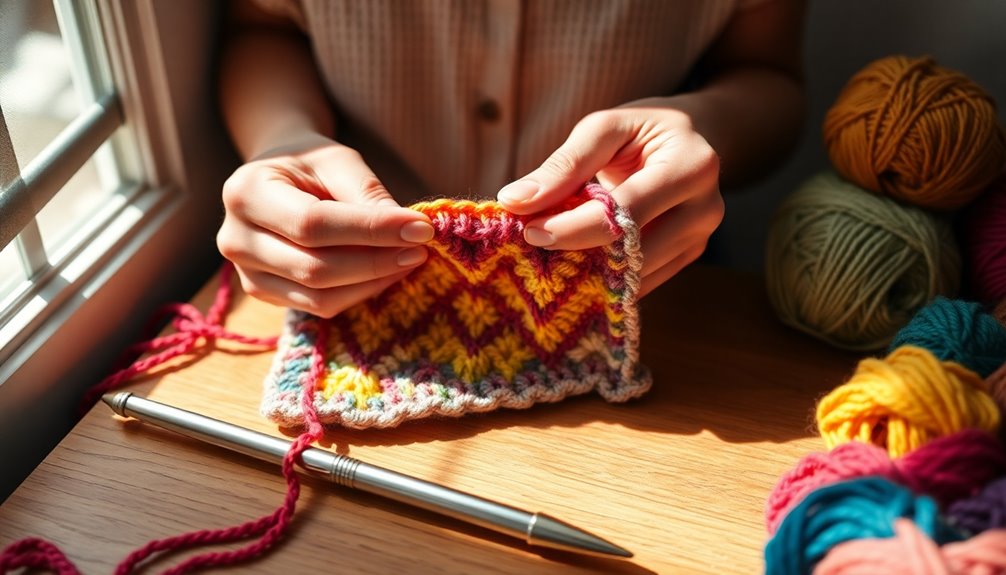
To master crochet, you need to get comfortable with essential stitches like single and double crochet.
Practice really does make perfect, so don't hesitate to create simple projects to hone your skills. As you repeat these stitches, you'll find your tension and technique improving greatly.
Essential Basic Stitches
Mastering essential basic stitches is essential for anyone looking to plunge into the world of crochet. These stitches form the foundation for your first projects and help you build confidence as you learn to crochet.
The key stitches you should focus on include:
- Single crochet
- Double crochet
- Half double crochet
Practicing these essential basic stitches will enhance your fluidity and consistency, important for achieving even tension in your work.
Start with simple projects like granny squares or chains, allowing you to become comfortable before moving on to more intricate designs.
Understanding crochet terminology will also make it easier to follow patterns, ensuring a smoother crafting experience as you explore both knitting and crochet.
Happy crocheting!
Practice Makes Perfect
While you may feel overwhelmed at first, practice truly makes perfect when it comes to mastering basic crochet stitches. Start by focusing on simple stitches like single crochet, half double crochet, and double crochet. These form the foundation for different projects and allow you to explore your creativity.
Make sure to use medium-weight yarn and an H-8 hook for an easier experience. Repeatedly practicing chain stitches builds muscle memory, improving your fluidity. Consider making sample swatches to evaluate your tension and stitch consistency.
Embracing Mistakes and Learning
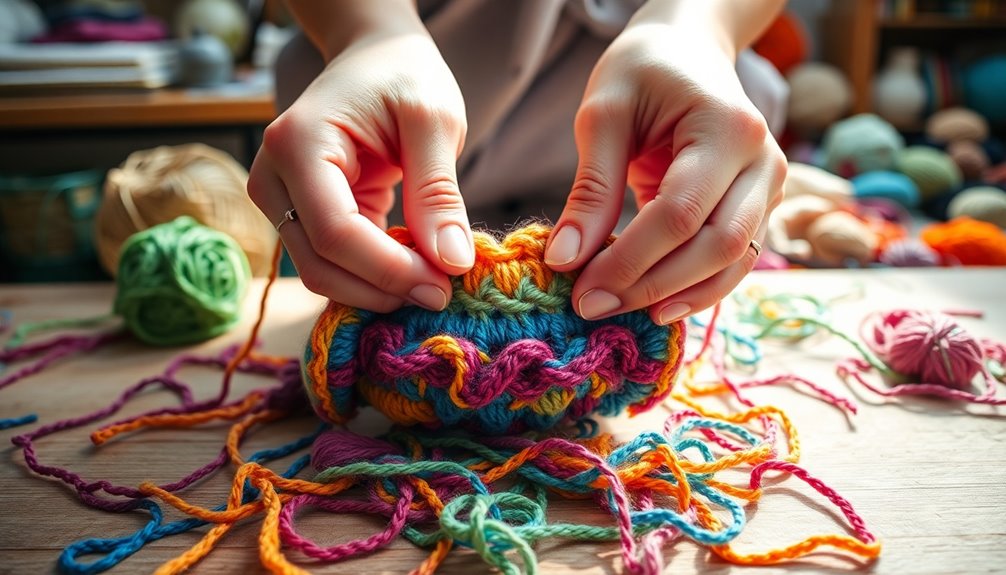
Mistakes are an inevitable part of your crochet journey, and embracing them can transform your learning experience. Instead of aiming for perfection, acknowledge that errors are stepping stones to creativity and growth.
By learning to correct mistakes, you'll enhance your technique and deepen your understanding of the craft.
Engage with the crochet community to share experiences and tips, making the process less intimidating. Remember, celebrating imperfections is a valuable tradition in many cultures; it reflects authenticity and humility.
- Embrace mistakes as learning opportunities.
- Connect with others in the crochet community.
- Shift your focus from perfectionism to creativity.
With this mindset, you'll find joy and fulfillment in every stitch, regardless of the outcome.
Building Confidence Through Practice
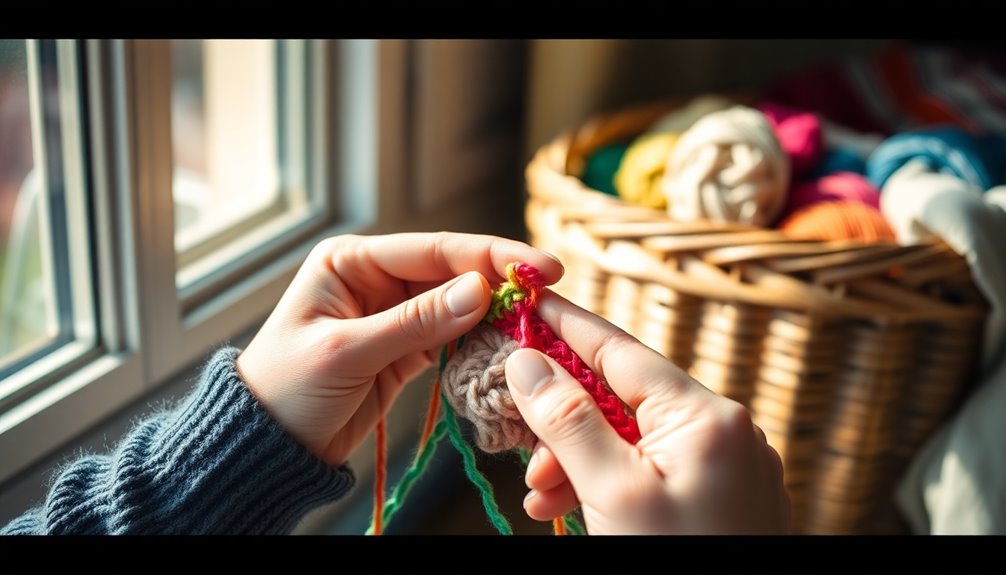
Embracing a growth mindset opens the door to building confidence in your crochet skills. Start by mastering a few basic stitches, like single crochet and double crochet, as these are your foundation.
Regular practice, even with simple projects like granny squares or chains, helps develop muscle memory. Don't hesitate to turn to online resources, such as YouTube tutorials, for visual guidance—repetition is key!
Joining a local crochet group or online community can provide a supportive environment where you can share experiences and tips. Additionally, reflecting on past mistakes can foster resilience and enhance your learning process as you advance in your crochet journey.
Frequently Asked Questions
Is It True That Machines Can't Crochet?
It's true that machines can't crochet the way you do.
While they mimic crochet techniques and produce items quickly, they lack the creativity and personal touch you bring to your projects.
The intricate nuances and unique designs you create by hand are impossible for machines to replicate.
Many crocheters appreciate this artistic experience, reinforcing the cultural significance of handmade crochet over machine-made items, which are often viewed as less authentic. This appreciation for handmade crochet fosters a sense of community and connection among crafters, as they often share techniques and patterns that have been passed down through generations. While some may experiment with crochet techniques for machine usage to enhance efficiency, nothing can truly replicate the care and individuality that comes with handcrafted pieces. Ultimately, the value of handmade crochet lies not only in its aesthetic qualities but also in the stories and emotions woven into every stitch.
Is Crocheting Supposed to Be Hard?
Crochet can seem tricky at first, but don't let doubts derail your determination!
With a bit of practice and patience, you'll find it's not as hard as you think. Start with simple stitches and small projects to boost your confidence.
Why Is Crocheting so Frustrating?
Crocheting can feel frustrating for you, especially at first. You might struggle with maintaining consistent tension or inserting your hook correctly. The foundation chain can seem awkward, leading to discouragement.
Using thinner yarn and smaller hooks may add to your challenges. Plus, if you don't grasp crochet terminology, you could misinterpret patterns.
Is There a Wrong Side to Crochet?
Curiously, in crochet, you'll often find that there's indeed a "wrong side," but it's not always a negative aspect.
Many patterns feature reversible stitches, allowing both sides to shine. You might notice that the wrong side can show more uneven stitches or loose ends, but with the right finishing techniques, you can create a polished look.
Embracing the wrong side can even enhance your designs, making your projects more versatile and appealing.
Conclusion
So, is crochet really that hard? It can feel intimidating at first, but as you unravel the mystery, you'll discover simplicity in each stitch. While the initial struggle might seem overwhelming, the joy of creating something beautiful from yarn makes every mistake worthwhile. Embrace those early challenges—they're just stepping stones to mastery. With patience and practice, you'll transform frustration into confidence, proving that what once seemed difficult can become your favorite hobby!
